Table of Contents
- Understanding the Basic Distinctions Between Horses and Ponies
- The Science Behind Size Classification in Equines
- Anatomical Differences that Define Horses and Ponies
- Popular Horse Breeds and Their Distinct Features
- Notable Pony Breeds Around the World
- Temperament and Personality Traits: Horse Pony Comparison
- Care Requirements and Management Differences
- Training and Riding Capabilities
- Cost Considerations: Comparing Horse and Pony Ownership
- Choosing Between a Horse and Pony: Factors to Consider
- Living Space and Housing Requirements
- The Versatility of Both Horses and Ponies in Various Disciplines
- Conclusion
- FAQ
Over 2 million Americans own horses or ponies. Each one brings its own world of traits and abilities. Knowing the differences between horses and ponies can change how we see these amazing animals.
At first glance, it might seem easy to tell horses from ponies by size. But there’s more to it. Their physical looks and personalities are just as varied. These animals are more than just their size.
Delving into the world of horses and ponies shows a wide range of breeds and behaviors. They offer companionship that appeals to people of all ages and backgrounds.
Key Takeaways
- Horses and ponies have distinct physical characteristics
- Size is not the only factor differentiating these equine companions
- Both horses and ponies can serve multiple purposes
- Understanding breed-specific traits enhances equine appreciation
- Proper care and management are crucial for both horses and ponies
Understanding the Basic Distinctions Between Horses and Ponies
Exploring the world of equines shows us interesting differences between horses and ponies. These animals share many traits but also have unique qualities. These differences make them special in the world of horses.
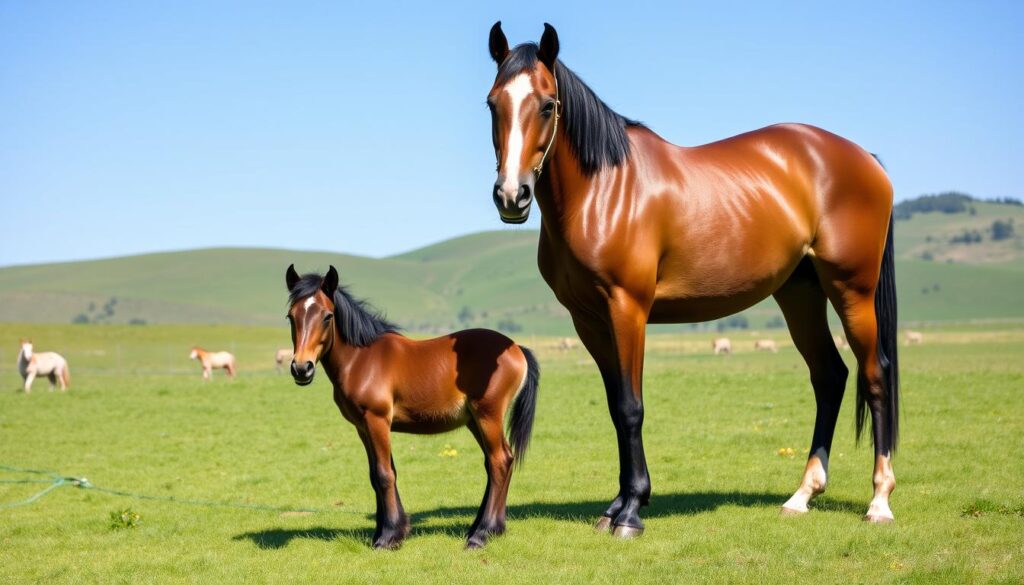
Height and Measurement Standards
Measuring the height of equines helps us tell horses from ponies. There’s a key height line:
- Ponies: Usually under 14.2 hands high (58 inches)
- Horses: 14.2 hands high and taller
“A hand is equal to 4 inches, making precise measurement crucial in equine classification.”
Physical Characteristics Overview
Ponies and horses have different looks:
| Characteristic | Ponies | Horses |
|---|---|---|
| Body Proportion | Stockier build | Longer, leaner body |
| Mane and Tail | Thicker, more robust | Typically more refined |
| Head Shape | Proportionally larger | More refined |
Common Misconceptions
Many think ponies are just baby horses. But they are unique breeds with their own traits. Ponies are strong and can carry adult riders, even though they are smaller.
- Ponies are not juvenile horses
- Size does not determine maturity
- Each breed has specific traits
The Science Behind Size Classification in Equines
Pony size classification is more than just measuring height. It involves understanding how equines grow. Factors like genetics, environment, and diet affect their size and type.
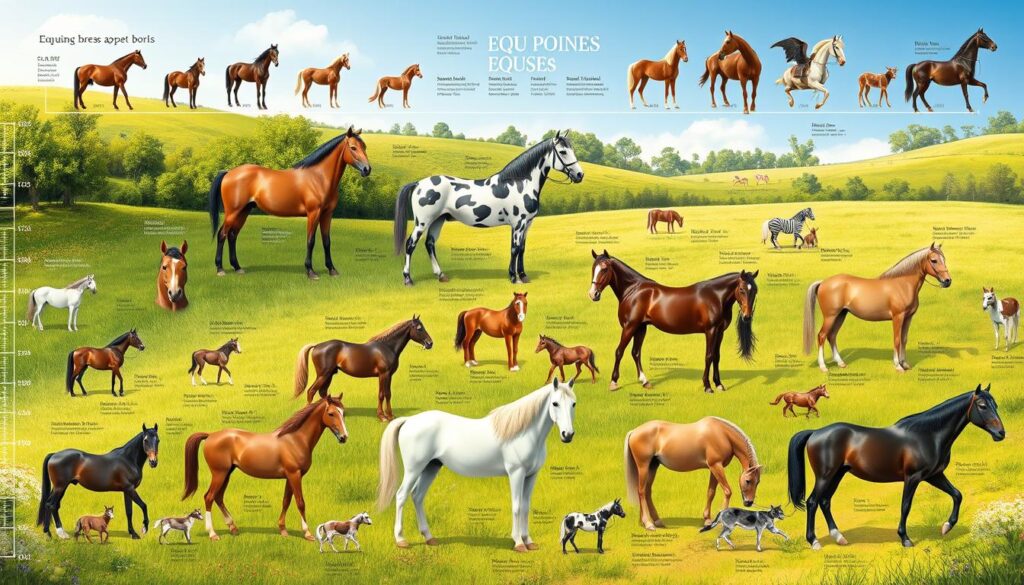
Scientists have set clear standards to tell horses from ponies. In the U.S., height is the main factor:
- Ponies: Typically measure 14.2 hands high or less
- Horses: Generally stand above 14.2 hands high
Genetic studies show how equines grow differently. Each breed has its own growth path. This is due to genetics, diet, location, and breeding.
- Genetic inheritance
- Nutritional factors
- Geographic location
- Breeding selection
“Size is not just a physical measurement, but a complex interplay of genetic potential and environmental influences.” – Equine Genetics Research Institute
The American Equine Sciences Association says size is more than height. It also looks at breed, bone density, and muscle. These factors help understand an equine’s size and type.
Researchers keep studying equine growth. They aim to learn more about these animals’ development and genetics.
Anatomical Differences that Define Horses and Ponies
Horse enthusiasts can learn a lot from the unique body features of horses and ponies. They might look alike at first, but they have special body traits. These traits show their unique strengths and abilities.
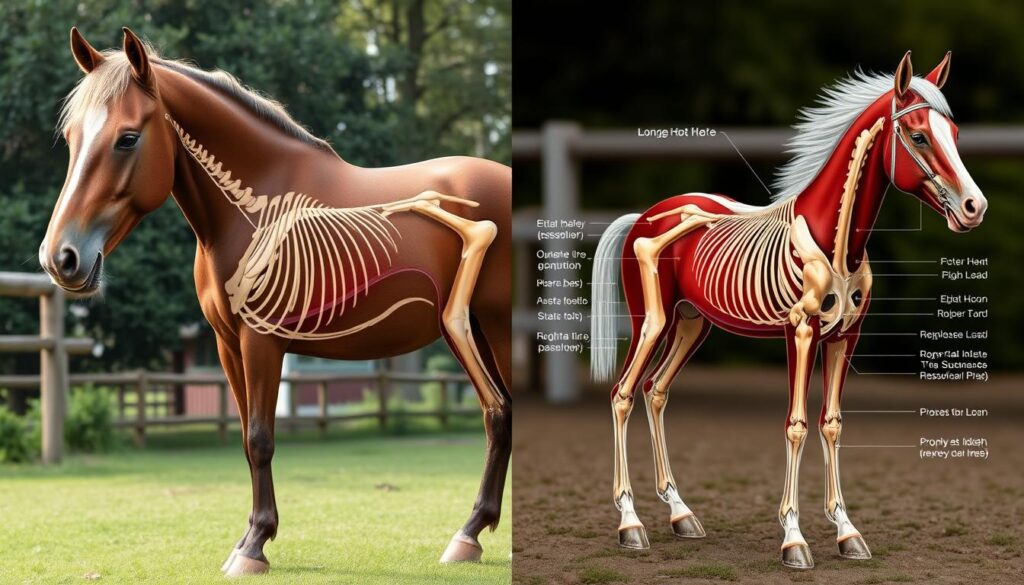
Ponies are known for their strength and hardiness. Their small size is not just cute. It shows their strong genetic makeup.
Bone Structure and Build
Ponies have bones that are different from horses:
- Shorter, thicker bones that are more durable
- Shorter legs compared to their body size
- Denser bones that support more weight
Muscle Distribution
The way muscles are arranged is key to how well an animal performs. Ponies have special muscles:
- More muscle in their back legs
- Compact muscles that make them powerful
- Muscles that help them handle tough terrains
Body Proportions
Horses and ponies look different in body shape. Ponies usually have:
- A wider chest for their size
- A shorter neck with strong muscles
- A rounder body that shows their adaptability
“Nature has crafted ponies as living proof that remarkable strength comes in small packages.” – Equine Research Institute
These body differences explain why ponies are admired for their toughness and unique looks.
Popular Horse Breeds and Their Distinct Features
The United States is home to a wide variety of horse breeds. Each breed has its own special traits. These traits range from the strength of working ranch horses to the grace of show horses.
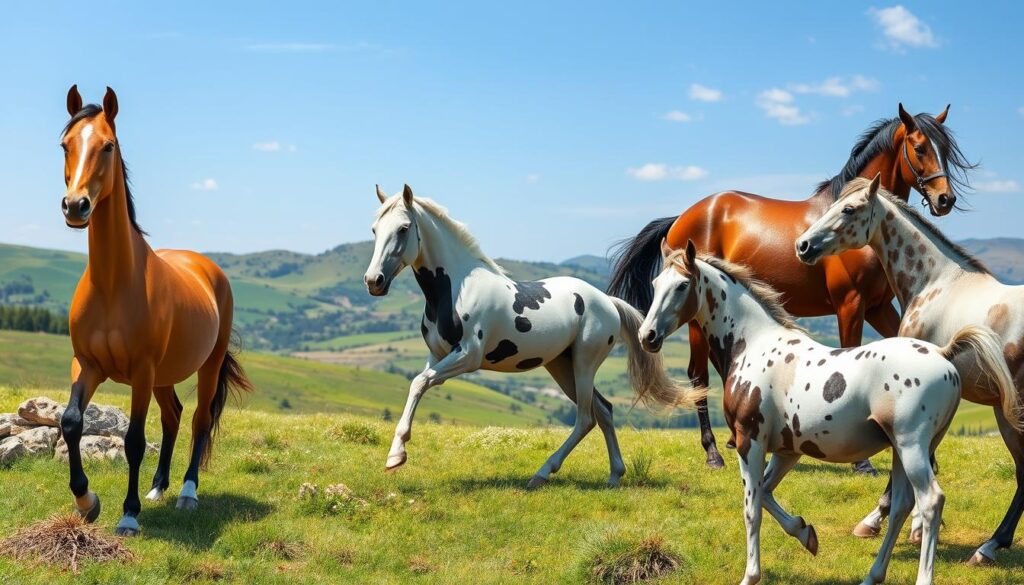
Let’s look at some of the most loved horse breeds in the United States:
- American Quarter Horse: Known for incredible speed and muscular build
- Thoroughbred: Renowned for racing and high-performance sports
- Arabian: Celebrated for endurance and elegant appearance
- Tennessee Walking Horse: Distinguished by smooth, unique gaits
“Each horse breed tells a story of adaptation, purpose, and extraordinary capability.” – Equine Historian
These breeds show a wide range of sizes, temperaments, and skills. Their unique traits come from long histories of careful breeding and adapting to their environments.
| Breed | Average Height | Primary Use | Typical Colors |
|---|---|---|---|
| American Quarter Horse | 14-16 hands | Ranch work, racing | Bay, sorrel, black |
| Thoroughbred | 15-17 hands | Racing, sport | Chestnut, bay, gray |
| Arabian | 14-15 hands | Endurance, show | Gray, bay, chestnut |
| Tennessee Walking Horse | 15-16 hands | Riding, performance | Solid colors, pinto |
These breeds are perfect for work, sports, or just being a friend. They show how diverse and adaptable horses are in the United States.
Notable Pony Breeds Around the World
Pony breeds are a world of diversity and unique traits. They have won the hearts of many riders and fans globally. From tough mountain ponies to sleek sport breeds, each has its own charm.
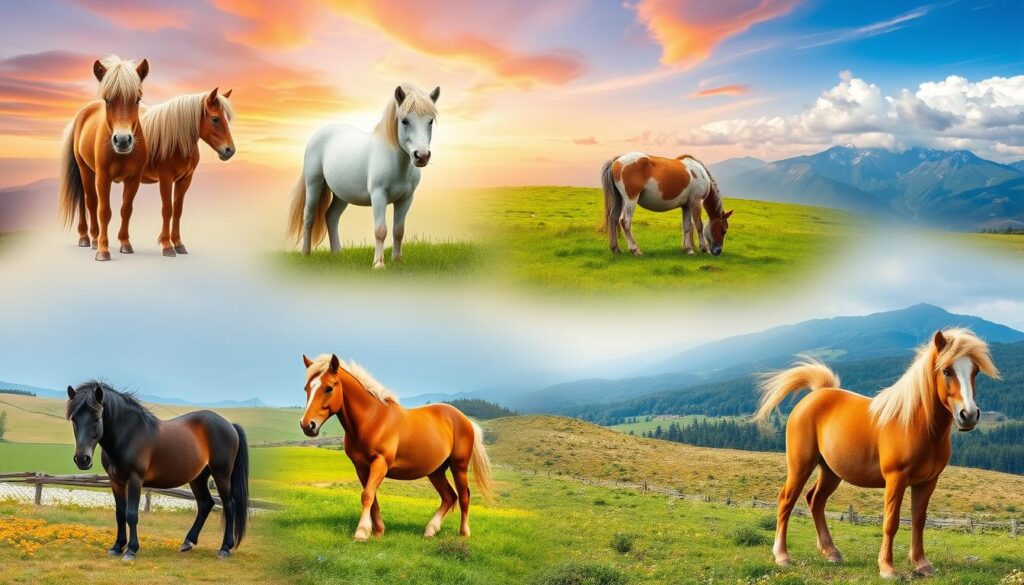
Mountain and Moorland Breeds
Mountain and moorland ponies are known for their toughness and ability to adapt. These traits make them ideal for tough terrains and harsh weather. Some famous breeds include:
- Welsh Pony: Known for its elegant movement and versatile nature
- Exmoor Pony: A rare breed with exceptional survival skills
- Highland Pony: Strong and resilient Scottish breed
Sport Pony Breeds
Sport pony breeds are known for their athleticism and versatility. They excel in competitions and offer top-notch performance.
| Breed | Origin | Key Characteristics |
|---|---|---|
| German Riding Pony | Germany | Athletic, graceful, excellent jumper |
| New Forest Pony | United Kingdom | Versatile, good temperament, suitable for riding |
Children’s Favorite Pony Breeds
Some pony breeds are favorites among kids because of their gentle nature and small size. These include:
- Shetland Pony: Tiny but sturdy breed
- Pony of the Americas: Colorful and kid-friendly
- Dartmoor Pony: Calm and patient disposition
“Every pony breed has a unique story and character that makes them special.” – Equine Expert
Exploring the world of pony breeds helps us appreciate their amazing adaptability. They shine in various environments and activities.
Temperament and Personality Traits: Horse Pony Comparison
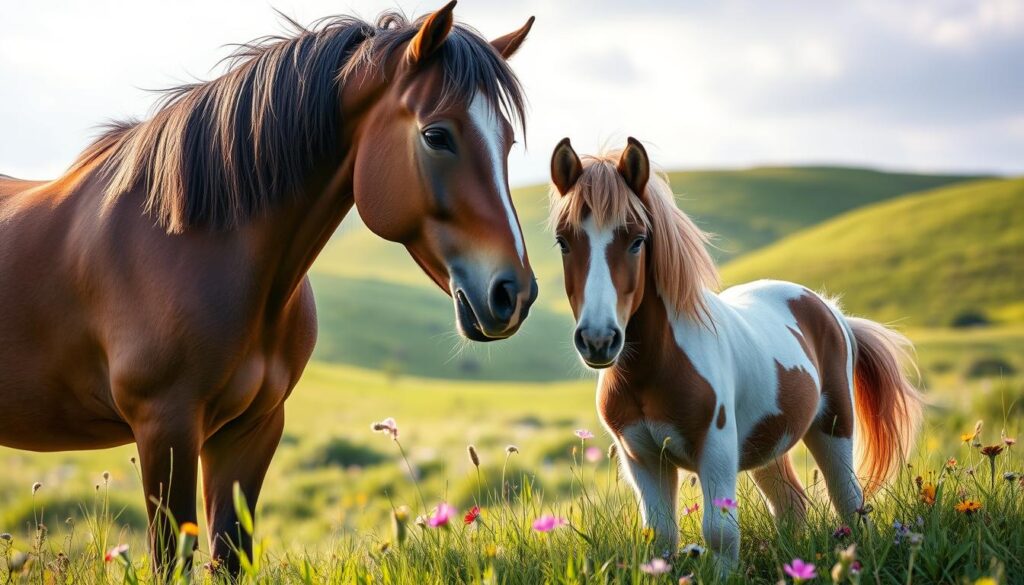
Exploring the temperaments of horses and ponies offers interesting insights. Pony temperament is often seen as more complex and varied. Each animal has its own unique personality traits.
Behavioral patterns show key differences between horses and ponies:
- Ponies are known for higher intelligence and independent thinking
- Horses are more people-focused and love to please
- Smaller equines often have stronger survival instincts
“Every pony and horse is an individual, with personality traits as unique as their physical characteristics.” – Equine Behavior Expert
Ponies are often seen as more stubborn. This trait comes from their survival skills in tough environments. Mountain and moorland pony breeds are known for their resilience.
| Characteristic | Ponies | Horses |
|---|---|---|
| Intelligence Level | High | Moderate |
| Trainability | Challenging | Generally Easier |
| Social Behavior | Independent | Cooperative |
Choosing an equine companion means understanding individual temperaments. Breed, training, and personal experiences greatly shape personalities. These factors go beyond general traits.
Care Requirements and Management Differences
Caring for horses and ponies needs special attention to their unique needs. They share many similarities but have different dietary needs and care requirements. This is key to keeping them healthy and happy.
When it comes to their diet, horses and ponies have different needs. Their metabolism affects their nutrition and overall health.
Feeding and Nutrition
Ponies have an efficient metabolism that can lead to weight issues. Their diet is different from horses in several ways:
- They need less food per body weight
- They are more likely to get fat
- They require controlled portion sizes
- They do well on low-sugar, high-fiber diets
“A pony’s diet is like a delicate balance – too much can be just as harmful as too little.” – Equine Nutrition Expert
Exercise Needs
Exercise is crucial for ponies’ health. Unlike bigger horses, ponies have more compact energy levels. They need careful activity planning:
- Daily time in pastures
- Moderate intensity workouts
- Regular riding or driving
- Mental stimulation through varied exercises
Health Considerations
Both horses and ponies face unique health challenges. Regular vet visits, dental care, and understanding breed-specific health issues are important.
Key health monitoring points include watching for metabolic disorders. Also, maintaining proper hoof care and ensuring the right vaccinations are crucial.
Training and Riding Capabilities
Understanding the training and riding capabilities of horses and ponies is key. It involves looking at their size and temperament. Each equine has its own traits that affect their suitability for different riding disciplines.
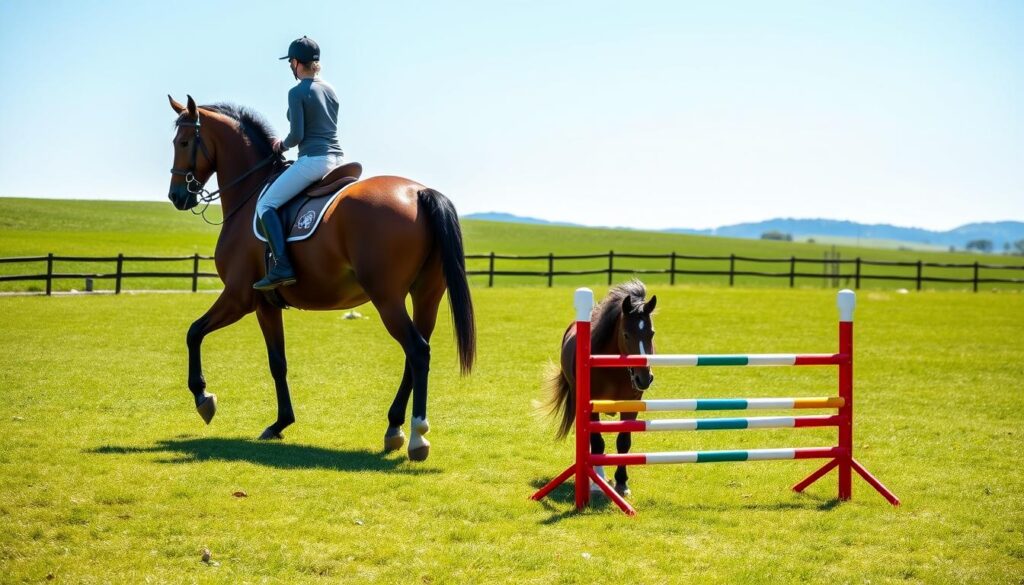
Riders need to know that a horse or pony’s temperament greatly affects their trainability. Horses usually do well in competitive disciplines. But ponies show great adaptability and intelligence in training.
- Horses are better suited for advanced riding techniques
- Ponies excel in specialized training environments
- Size impacts training complexity
“The key to successful equine training is understanding individual personality and physical capabilities.” – Professional Equestrian Trainer
Different riding disciplines require specific skills from horses and ponies. Important factors include:
| Discipline | Horse Suitability | Pony Suitability |
|---|---|---|
| Dressage | High precision | Excellent agility |
| Jumping | Power and height | Nimble movement |
| Trail Riding | Endurance | Steady temperament |
Choosing the right equine partner is crucial. It depends on matching rider skill, physical attributes, and training goals. Getting professional guidance can help riders make the right choice.
Cost Considerations: Comparing Horse and Pony Ownership
Knowing the cost of owning an equine friend is key for those thinking about it. The prices for horses and ponies differ a lot. This affects your budget and how you care for them over time.
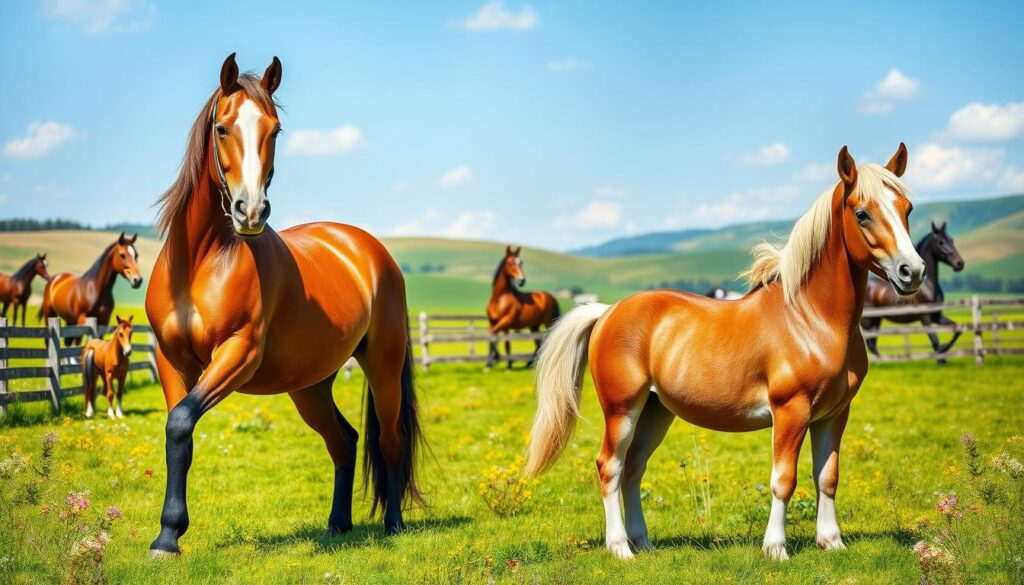
Initial Purchase Expenses
Looking at the cost of horses versus ponies, the price is a big factor. Ponies are usually cheaper because they are smaller. Prices depend on:
- Breed quality and lineage
- Age and training level
- Current market demand
Ongoing Maintenance Costs
It’s important to plan for regular costs when caring for a pony. Monthly expenses include:
- Feed and nutrition
- Veterinary care
- Farrier services
- Boarding or stable expenses
“The true cost of horse ownership isn’t just the initial purchase—it’s the ongoing commitment to their health and well-being.” – Equine Expert
Equipment Requirements
Horses and ponies need different gear. Ponies need special tack and equipment, which might seem cheaper but is still unique.
| Expense Category | Horse | Pony |
|---|---|---|
| Initial Purchase | $3,000 – $10,000 | $1,500 – $5,000 |
| Monthly Maintenance | $300 – $500 | $200 – $400 |
Before getting a horse or pony, think about your finances and long-term plans.
Choosing Between a Horse and Pony: Factors to Consider
Choosing the right horse or pony is a big decision. It depends on many factors that affect your riding fun and satisfaction. Think about what you need and what you want from your equine partner.
The personality of the horse or pony is very important. Ponies are often more lively and smart. Horses, on the other hand, are usually calmer and more steady.
- Rider’s Age and Size: Smaller riders might find ponies more comfortable
- Skill Level: Beginners may benefit from more patient equine companions
- Intended Use: Competitive riding, leisure, or training purposes
Size matters when picking a horse or pony. Ponies under 14.2 hands high have their own perks compared to bigger horses.
“The perfect equine partner is not about size, but about connection and compatibility.” – Professional Equestrian Trainer
Think about these key points when choosing:
- Available Living Space
- Financial Investment
- Personal Riding Goals
- Long-term Care Requirements
Remember, each horse and pony brings unique characteristics to your equestrian journey. Take time to research, interact with different breeds, and consult experienced professionals to make an informed decision.
Living Space and Housing Requirements
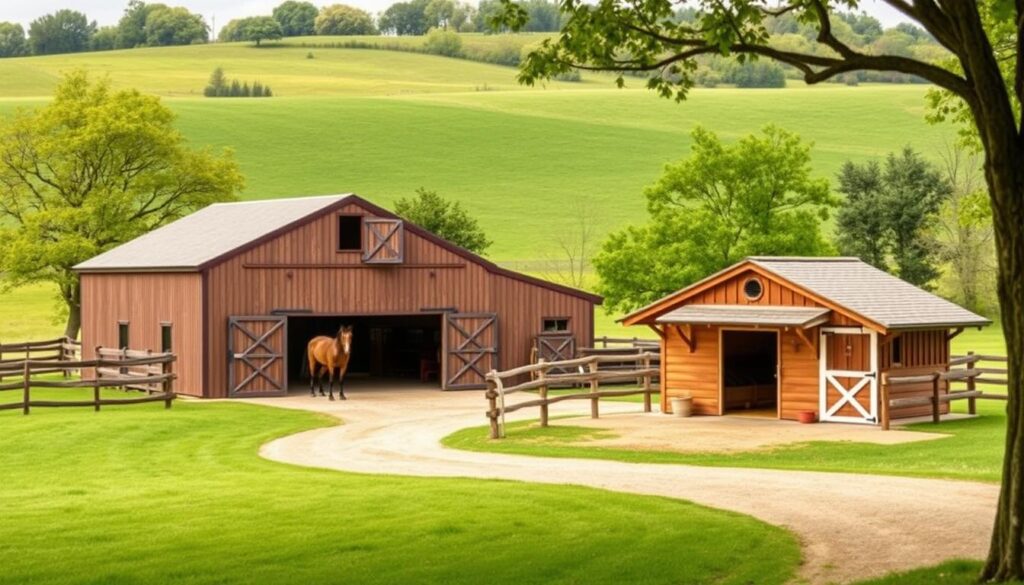
Creating the right living environment is key for horses and ponies. Pony care tips show that space needs differ. Horses and ponies need enough room, but their housing needs vary.
Space needs depend on several factors:
- Breed size and characteristics
- Number of animals
- Local climate conditions
- Pasture quality
Here are some space guidelines:
| Animal Type | Minimum Pasture Size | Shelter Requirements |
|---|---|---|
| Horses | 1-2 acres per animal | 12×12 foot stable/shed |
| Ponies | 0.5-1 acre per animal | 10×10 foot stable/shed |
Fencing is another critical aspect of equine housing. Ponies are known for being more clever escape artists. They need sturdy, well-maintained enclosures. Wooden or mesh fencing at least 4-5 feet high works best for preventing wandering.
“Good housing isn’t just about space, it’s about creating a safe, comfortable environment for your equine companion.” – Equine Veterinary Association
Regional variations in the United States impact housing needs. Southern states require more shade, while northern regions need robust shelters. Understanding these nuances helps ensure your equine friend stays healthy and comfortable.
The Versatility of Both Horses and Ponies in Various Disciplines
Horses and ponies are incredibly adaptable in many areas. They show that size doesn’t stop them from being great. They are amazing in competitions, fun activities, and helping people.
Each breed of horse and pony has its own special talents. They are perfect friends and athletes.
Competition Uses
Competitions show how versatile horses and ponies are. They take on tough challenges in:
- Show jumping
- Dressage
- Cross-country eventing
- Racing competitions
- Endurance challenges
Recreational Activities
Horses and ponies also bring joy to people in fun activities:
- Trail riding
- Driving
- Western riding
- Leisure carriage driving
- Pleasure riding
Therapeutic Applications
Therapy programs use horses and ponies to help people. They help with healing and growing.
| Therapy Type | Horse/Pony Characteristics | Therapeutic Benefits |
|---|---|---|
| Physical Rehabilitation | Gentle Movement | Muscle Strength |
| Mental Health Support | Emotional Sensitivity | Anxiety Reduction |
| Child Development | Size Adaptation | Confidence Building |
Each horse and pony has special qualities. They are amazing partners in many areas, going beyond size.
Conclusion
Looking into the differences between horses and ponies opens up a world of fascinating diversity. These animals share many traits but also have unique qualities that set them apart. Both horses and ponies can live for 25-30 years with the right care.
When choosing an equine partner, it’s important to think about your needs and goals. Ponies might be better for families or those with less space. Horses, on the other hand, are great for serious riders or farm work. Each animal has its own personality and abilities.
The decision between a horse and pony depends on your situation. Consider your riding experience, what you plan to use the animal for, your budget, and the care you can provide. Whether you want a pony or a horse, both offer amazing chances for friendship, fun, and growth in the world of horses.
To find the perfect equine friend, do your research and talk to experts. Getting to know the animals firsthand is also key. This way, you can match your lifestyle and dreams with the right four-legged companion.
FAQ
What is the main difference between a horse and a pony?
Horses are taller than 14.2 hands (58 inches). Ponies are 14.2 hands or shorter. This height difference is key. But, there are also differences in body shape, bone structure, and overall build.
Are ponies just baby horses?
No, ponies are not baby horses. They are a unique type of equine. Ponies stay small their whole life. They have sturdy bodies, thick manes and tails, and are often healthier.
Can ponies and horses breed with each other?
Yes, ponies and horses can breed. Their offspring are called mules or hinnies. But, these hybrids are usually unable to have babies themselves. Breeding them can create interesting size and characteristic variations.
Do ponies have different temperaments compared to horses?
Ponies are often seen as smarter and more stubborn than horses. They like to do things their own way. But, every pony is different. Their personality can depend on their breed, training, and individual traits.
Are ponies stronger than horses relative to their size?
Yes, ponies are stronger than horses when you compare their weight to size. Their strong build lets them carry more weight. This makes them great for hard work and for riders who are smaller.
What are some popular pony breeds?
Popular pony breeds include the Welsh Pony, Shetland Pony, Connemara Pony, Dartmoor Pony, and Exmoor Pony. Each has its own special traits. They come from different places and are good for different jobs.
How long do horses and ponies typically live?
Ponies live longer than horses. Horses usually live 25-30 years. Ponies can live 30-40 years with good care. Their diet, health, and living conditions affect how long they live.
Are ponies more suitable for children?
Ponies are great for kids because they are smaller. This makes them less scary and easier to handle. But, it’s important to pick a calm pony and teach kids how to ride safely.
Do horses and ponies have different nutritional needs?
Yes, ponies and horses need different food. Ponies are more likely to get fat. They need less food than horses because they are smaller. Horses need more food because they are bigger and use more energy.
Can ponies be used in competitive equestrian sports?
Absolutely! Ponies do well in sports like show jumping, dressage, eventing, and driving. There are special pony competitions where they can show off their skills.